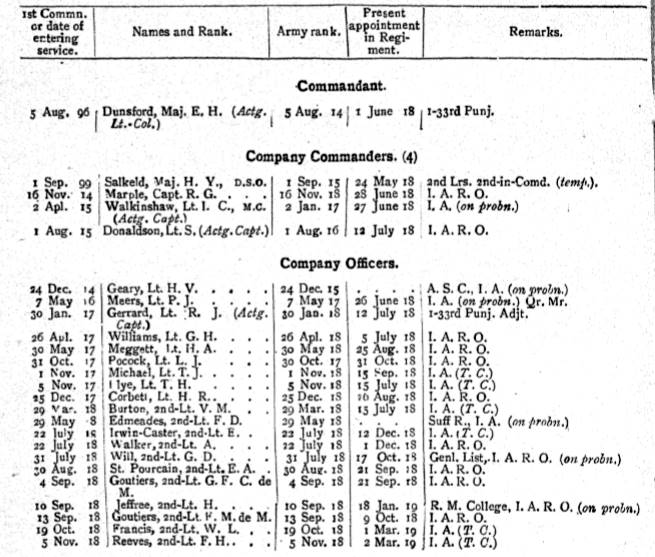This article on the 2nd Battalion 69th Punjabis aims to help you research either the Battalion or a soldier who served with it during the First World War. I have also written a separate article for the 1st Battalion 69th Punjabis and have created a series of guides to help you research soldiers who served in the Indian Army during the First World War. The links below will take you to the guides:
- Guide to the 1st Battalion 69th Punjabis
- Guides to Researching Soldiers who Served in the Indian Army
The 2nd Battalion 69th Punjabis in the First World War
Lineage: The 2nd Battalion 69th Punjabis was formed at Ambala (Haryana, India) on 28 May 1918 and disbanded on the 23 April 1922. For a history of the Regiment’s lineage see my page on the 1st Battalion 69th Punjabis.
Class Composition of Battalion in 1919: 2 Companies of Bishnois Jats, 1 Company of South-Western Punjabi Muslims and 1 Company of Gadarias. July 1921: 2 Companies Punjabi Muslims, 1 Company Sikhs (other than Jat Sikhs) and 1 Company Punjabi Hindus (excluding Dogras).
The 2nd Battalion 69th Punjabis was formed at Ambala (Haryana, India) on 28 May 1918. The first Commanding Officer was Acting Lieutenant-Colonel E. H. Dunsford appointed on 1 June 1918 from the 33rd Punjabis. The majority of the Battalion’s British officers were initially drawn from the Indian Army Reserve of Officers (I.A.R.O.) or were Indian Army officers on probation. The extract below was taken from the April 1919 Indian Army List and recorded the British officers serving with the Battalion.

The system of training and the delegation of authority appears to be good. The assistance of British Non-Commissioned Officer Instructors would have improved matters. Drill was fair. Musketry and Physical and Bayonet Training good. Discipline good. The battalion is well commanded by Lieutenant-Colonel Dunsford, assisted by a number of keen and capable officers.
The system is good and the results are good, considering the poor material of which the regiment is mainly composed and the fact of such a large number of recruits being sent to the battalion at one time and the paucity of instructors, and not many of the Indian Officers have experience the great part of them being direct commissions.
I agree with the Commanding Officer that Bishnois and S. W. Punjabi Mussulmans will be useful but think it improbable the Gaderias ever will.
Confidential review reports on Indian Army units, depots, British officers, etc. for 1918-1919: IOR/L/MIL/7/17030
On 24 May 1919, the Battalion joined the North West Frontier Force from Ambala where it served at Kohat. In the July 1921 Indian Army List, the Battalion was serving in Waziristan with its Depot at Ferozepore (Firozpur, Punjab, India). 1 officer, Captain Philip James Meers who died of pneumonia and 20 soldiers of the 2nd Battalion 69th Punjabis are commemorated on the Delhi Memorial (India Gate). The Battalion was disbanded on 23 April 1922.
War Diaries of the 2nd Battalion 69th Punjabis
Unfortunately, there are no war diaries for the 2nd Battalion 69th Punjabis.
Further Sources for the 2nd Battalion 69th Punjabis
For information regarding British and Indian officers who served with the 2nd Battalion 69th Punjabis, the Indian Army List should be consulted. Surviving Confidential Reports for the Battalion are held at the British Library: Confidential Reports on Regiments etc which also contain the annual reports of the British officers serving with the Battalion.
